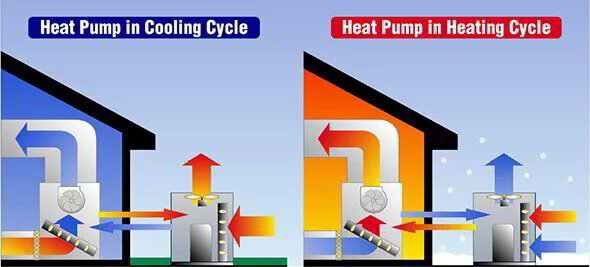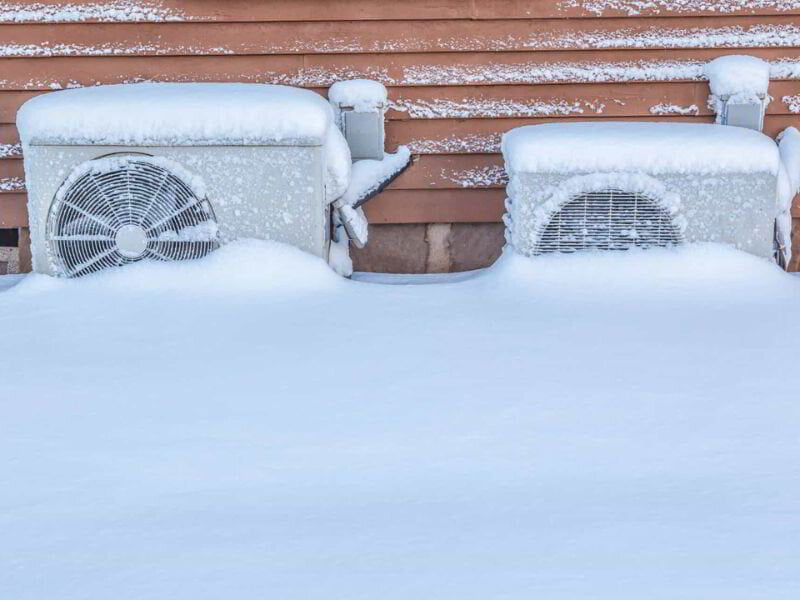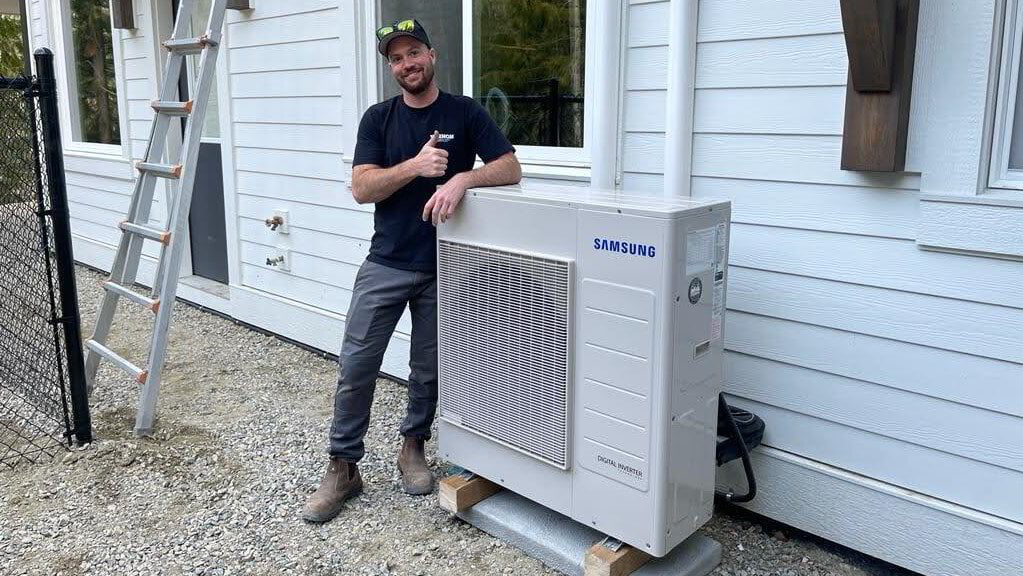Heat pumps are very quickly growing in popularity throughout North America.
Compared to a typical electric furnace or gas furnace, a heat pump can provide much more efficient and powerful heating, all while using less energy.
However, they can struggle to keep the house warm when the outdoor temperature is very low.
To keep your home warm in very cold temperatures, many heat pumps use emergency heat.
Typically, a heat pump will switch to emergency heat when the temperature drops below 30° Fahrenheit, but it can also switch over due to other factors that we will explore in this article.
Blog Table of Contents
How A Heat Pump Works

Heat pumps work in tandem with the outside air to provide heat to the home while simultaneously expelling cold out.
A sophisticated procedure called heat transfer is used to heat the home. When switched to heating mode, the heat pump will extract heat energy from the outdoor air and release it into the home.
At the same time, cold air inside the home is sucked into the vents by the heat pump system and is released out into the outdoor air.
By taking in heat from outside temperatures and getting rid of unwanted cold air, the heat pump efficiently and effectively heats the home.
What is Emergency Heat?

Though heat pumps are generally reliable, they can struggle in certain circumstances and even might fail.
To stop you from going without heat, heat pumps have a backup heat source called emergency heat.
In this mode, only the indoor unit and the backup heating system will continue to run.
It’s worth noting that though most heat pumps have some kind of emergency heat setting, not all heat pumps do. This mainly depends on the model and manufacturer’s preferences.
Unlike a normal heat pump which relies on fluctuating outside temperatures to run, emergency heating is powered solely by electricity. This has both positive and negative outcomes:
The Upside to Emergency Heat
Emergency heat can be very important in extremely cold weather.
Extreme cold can severely impact your health, especially if you already have a diminished immune system or problems with blood pressure.
As a result, having access to a backup heating source in cold weather is really a must-have.
Additionally, this backup heating system is typically a lot more effective than other stand-in heating solutions. It can provide heat quickly and abundantly and can be dispersed throughout the home just as normal heating systems do.
The Downside to Emergency Heat
Though emergency heat has numerous qualities that make it a capable heating solution, there is one very strong downside: the energy bill.
Emergency heat works using a type of heating called electric resistance heating. This heating is typically run using an electric heat strip that is 100% energy efficient.
However, though the strip is very efficient with electricity, emergency heat is incredibly inefficient in creating electricity. The generator used to make the system’s electricity, normally powered by gas or oil, is only around 30% efficient!
Consequently, you can expect your electricity bill to be 3 to 6 times higher than when your heat pump is operating.
This is why you should only use the emergency heat setting in emergency situations. Otherwise, you might as well be burning dollar bills to heat your home.
What Makes Your Heat Pump Switch to EM Heat Mode?

A number of different problems can make your primary heating system stop, causing emergency heat mode to come on.
These include:
Below Freezing Temperatures
As we examined earlier, a heat pump relies on extracting heat from the outside temperature to function.
As temperatures drop, increasingly less heat is present in the air which makes it increasingly more difficult for the heat pump to run.
At a certain point, normally when the temperature drops below 30° Fahrenheit, there’s no longer enough heat in the air for the heat pump to effectively warm your home.
So when the heat pump thermostat detects an outside temperature of 30° or below, it will automatically switch to emergency heat.
Heat Pump Failure
Any heating system could theoretically stop working at any time. This doesn’t have to be due to extreme cold; damage from an ice storm or worn-down internal components could also cause your heat pump to break down.
To prepare for this possibility, your heat pump is set to switch to emergency heat if it’s suddenly unable to keep running. To check that your heat pump is working properly, there are two key methods.
The first is to listen to the motor. If there are any strange or unusual sounds coming out of the unit, or just no sound at all, this is a clear sign something is wrong.
The other method is to see if any air is blowing out of the heat pump. If you can’t feel anything, then the system clearly isn’t running.
Manual Input
Your heat pump might be on emergency heat mode simply because you put it onto emergency heat mode.
Most modern heat pumps allow you to turn on emergency heat using the thermostat. This will usually be shown by a red indicator light or the words “EM heat” on the thermostat screen.
If your heat pump is on an emergency heat setting and you don’t want it to be, the solution may be as simple as just turning it off on the thermostat.
If you find that the emergency heat light of your thermostat is turned on but isn’t actually running, this is most likely indicative of a problem with your outdoor unit. If your red indicator light stays on for a long time, you’ll need an HVAC professional to take a look at it.
EM Heat vs. AUX Heat

When talking about the emergency heat setting of a heat pump, many people get confused between emergency heat (EM heat) and auxiliary heat (AUX heat).
Both are external heating systems to the heat pump and its heating process. However, their functions are quite different.
Auxiliary heat serves as a secondary heating source to the heat pump and runs alongside the heat pump. When the outdoor temperature drops sharply, the auxiliary heat helps the heat pump make up the difference without taking over from it.
When you use emergency heat, on the other hand, it is not a secondary heat source but the only heat source being used. It does not provide supplemental heat but is an independent backup system that runs by itself until it the EM heat setting is turned off on the thermostat.
Final Thoughts
Emergency heat is both a blessing and a curse. In the most freezing weather, EM heat will save you from the cold and keep your home at your desired temperature.
However, it is also very expensive and thus not a great long-term option if you want to stay warm.
Many emergency heat systems work in conjunction with natural gas or oil heat generators, which can make them difficult and dangerous to fix on your own.
Upstate Home Maintenance Services is at hand if your heat pump needs to be repaired.
Our expert HVAC services are renowned throughout Spartanburg County, SC.
If you’re freezing and need your heat pump fixed immediately, feel free to call us.
This article was written by Morgan Loch
Owner of Upstate Home Maintenance Services LLC and Local HVAC Guru


